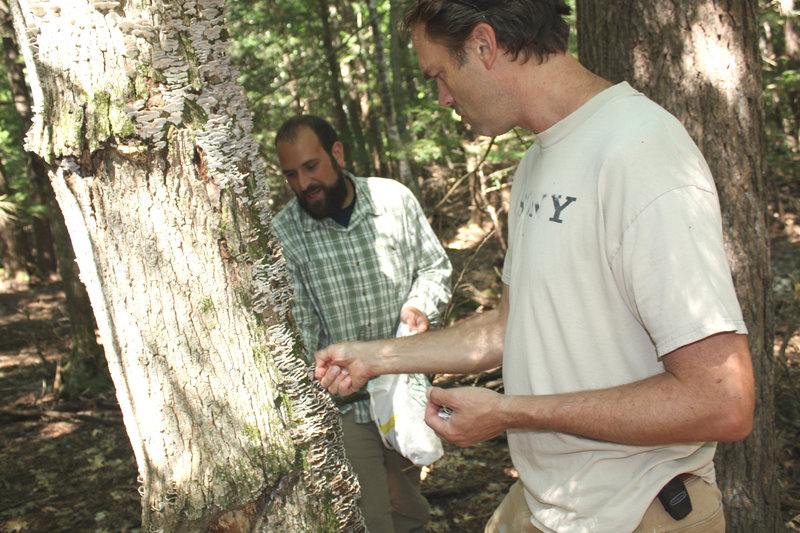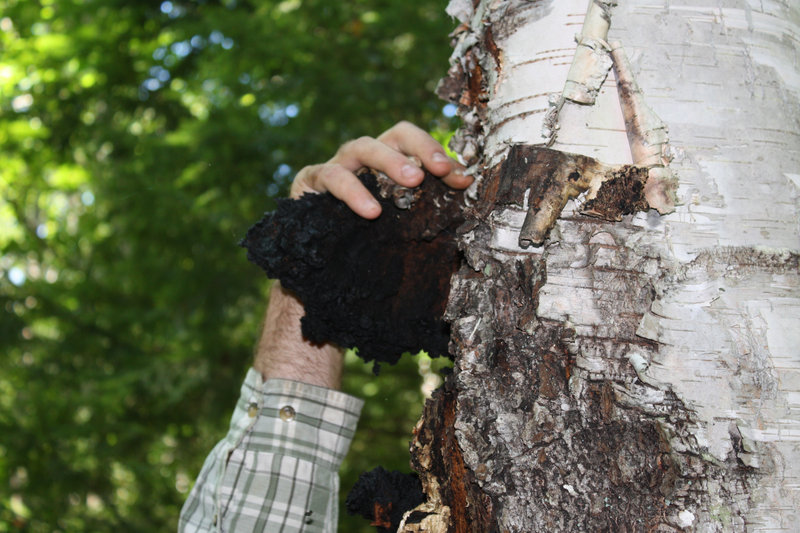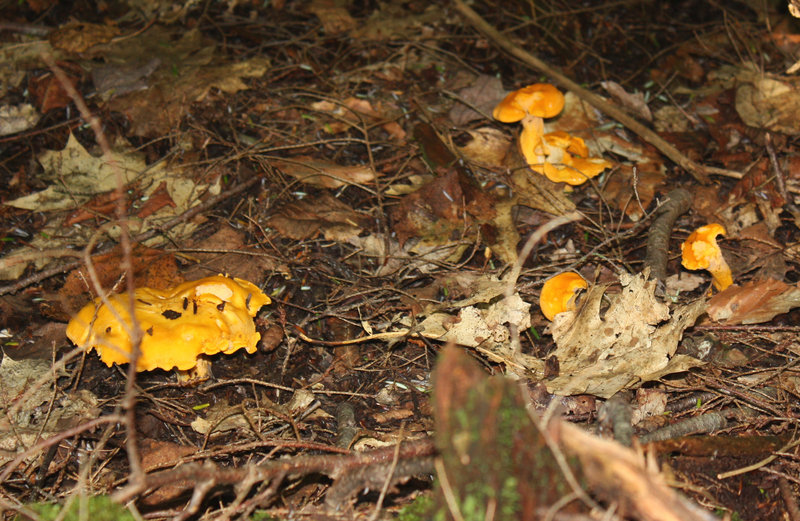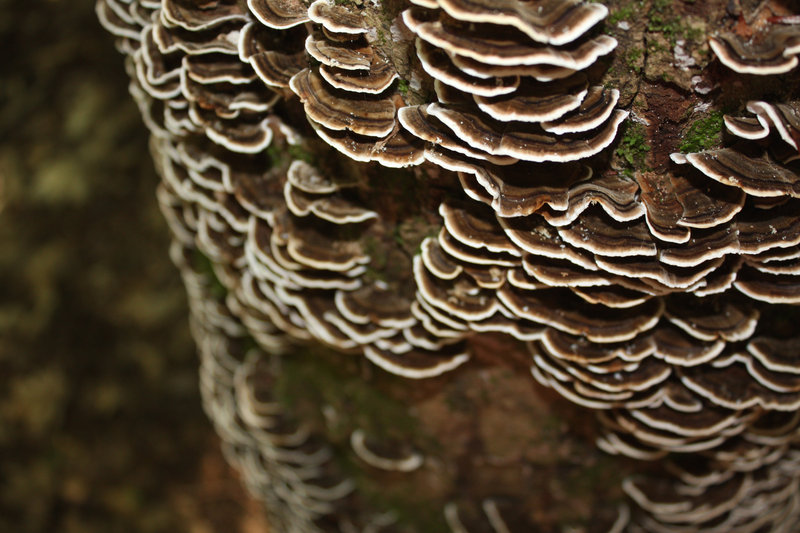“Whoa,” shouts Dan Agro, a mushroom expert who runs AgroMyco, as he spots a dead birch tree with a characteristic growth coming out of its side. “Come out here.”
Agro, property owner Nathan Burrill and I have been traipsing through Burrill’s mossy, boulder strewn and hilly woods in Windham searching for edible and medicinal mushrooms.
After we make our way to the base of the birch tree, we gaze high above our heads at two dark, misshapen knots protruding from either side of the white bark. We all ponder the same question: is the growth the sought-after medicinal mushroom known as chaga or is it a wooden burl?
Agro hoists Burrill into the air so he can cut off a piece of the growth. When he hands over the specimen, Agro quickly pronounces it a burl.
But in the elusive and unpredictable world of mushroom hunting, one false find can quickly lead to a more fruitful discovery. Just beyond the birch tree a patch of bright orange-yellow stands out against the brown leaf litter on the forest floor.
Agro bends down and quickly pronounces the patch to not only be mushrooms but to be tasty chanterelles, typically found on high-end restaurant menus and in gourmet shops. These ones are not the most picturesque specimens, as they’re a little chewed on, but they’ll still make good eats.
“These are probably a week old,” Agro says as he proceeds to cut off each mushroom at the base and then brushes off any dirt and debris. Once he gets them home, he’ll clean them further with a paper towel, but he’ll avoid rinsing them, as it makes the mushrooms too soggy.
ON THE TURKEY TAIL TRAIL
A short while later, we come across a tree trunk covered in ruffled waves of striated turkey tail mushrooms, which are prized in Asia for anti-cancer and anti-inflammatory properties.
“Turkey tail is one of the most prevalent mushrooms you’ll find in this area,” Agro says as he tears the mushrooms off in strips and places them in a bag.
Since turkey tails are rather tough and leathery, they are typically consumed as a tea or a broth, after boiling them to extract their beneficial properties.
Agro’s interest in mushrooms began 11 years ago, when he started cultivating oyster and shiitake mushrooms. Four years later, he began foraging for wild mushrooms.
These days, he frequently leads public walks to teach others how to find and identify the bounty of edible and medicinal mushrooms lurking in the Maine woods. His next public walk takes place on Sept. 16 in Portland.
“The best way to reach more people and give them a better relationship with mushrooms is to get them out and teach them (how to forage),” Agro said. “I don’t think people realize we have such a diverse amount of wild mushrooms in Maine.”
While some mushroom walks focus on identifying all the fungi encountered, whether edible or not, Agro chooses to spend the bulk of the time on his walks spotting edible mushrooms and pointing out how to recognize them.
“I’m just interested in the edibles and ones that are a resource to us,” Agro said.
Agro cautions that mushroom hunting is not the same as a vigorous hike through the woods. Rather, it’s a slow walk where you watch where you’re stepping while scanning the ground and the nearby tree trunks for signs of fungi.
He says peak mushroom foraging season in Maine starts now and typically runs through the end of October.
“It’s either feast or famine a lot of the time,” said Agro, who also works as a GIS mapping consultant.
After keeping some of the mushrooms he finds and grows for his own meals, Agro sells the rest to local chefs or barters them for other goods with members of the Portland Maine Permaculture Meetup, which hosts a monthly swap event.
GROW YOUR OWN
Agro also collects spores from edible wild Maine mushrooms and offers them to people who want to cultivate native fungi on their own property.
“I recently got a reishi species onto a petri dish,” Agro said.
When asked why mushrooms offer health benefits, Agro said, “pretty much all mushrooms have immune systems. When we consume them, they impart some of that immunity to us.”
But in order to receive immune benefits, the mushrooms must be picked in an active growth stage when their immune function is at its highest level. In order for our bodies to absorb the immune qualities and nutrition from mushrooms, the fungi must be cooked first.
“All mushrooms are comprised of chitin, and chitin doesn’t get broken down until we cook it,” Agro said. “Cooking is a very important thing for all mushrooms. You don’t get any mushroom benefits from mushrooms if they’re raw.”
So while those raw button mushrooms may look pretty on your salad, they have about the same nutritional benefits of wood chips.
To develop wild mushroom foraging skills, Agro said “the key is getting out there and spending as much time in the woods as possible.”
For Agro, and no doubt many mushroom hunters, he said “until I find it, touch it and see it, my brain doesn’t really connect with it. Once you have six or seven mushrooms you’re comfortable with, you’ll generally find something when you go out. You’re just not sure what it will be.”
Proving mushroom hunting’s unpredictably, Agro’s sharp eyes spotted a chaga growth on a birch tree, when we were making our way out of the woods.
As he broke the chaga mushroom off in pieces, revealing its yellowish-brown center beneath the blackish outer skin, Agro said, “It’s probably been on there for 15 years.”
By now, the chaga is dried and ready to be transformed into a medicinal tea.
Staff Writer Avery Yale Kamila can be contacted at 791-6297 or at: akamila@pressherald.com
Twitter: AveryYaleKamila
Send questions/comments to the editors.





